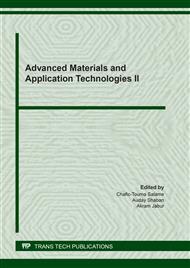[1]
H. Nosrati1, S. Pourmotabed, E. Sharifi, A Review on Some Natural Biopolymers and Their Applications in Angiogenesis and Tissue Engineering, J. Appl. Biotechnol Rep. 3 (2018) 81-91.
DOI: 10.29252/jabr.05.03.01
Google Scholar
[2]
A. Chauhan, and P. Chauhan, Natural Fibers and Biopolymer, J. Chem. Eng. Process Technol. 6 (2013),.
Google Scholar
[3]
L. Ranakoti, M. Pokhriyal, A. Kumar, Natural Fibers and Biopolymers Characterization: A Future Potential Composite Material, Journal of Mechanical Engineering, 68 (2018) 33 -50.
Google Scholar
[4]
I. Abd Ulrazzaq Kadhim, Z.Jabbar Abdul Ameer and A. Bassm Alzubaid Investigation of Chitosan Film Degradation in Tissue Engineering Applications, IOP Conf. Series: Materials Science and Engineering, 671 (2020) 012060 IOP Publishing.
DOI: 10.1088/1757-899x/671/1/012060
Google Scholar
[5]
P. Chocholata, V. Kulda and V. Babuska, Fabrication of Scaffolds for Bone-Tissue Regeneration, Materials 12(2019) 568;.
DOI: 10.3390/ma12040568
Google Scholar
[6]
T. Clement Mokhena, M. Jonas Mochane, Asanda Mtibe, Maya Jacob John, E. Rotimi Sadiku and J. Shale Sefadi, Electrospun Alginate Nanofibers Toward Various Applications: A Review" Materials, 13(2020) 934.
DOI: 10.3390/ma13040934
Google Scholar
[7]
K.T. Shalumon, K.H. Anulekha, Sreeja V. Nair, S.V. Nair, K.P. Chennazhi, R. Jayakumar, Sodium alginate/poly(vinyl alcohol)/nano ZnO composite nanofibers for antibacterial wound dressings, International Journal of Biological, Macromolecules 49 (2011) 247–254.
DOI: 10.1016/j.ijbiomac.2011.04.005
Google Scholar
[8]
S. Saravanan, C. Anjali, M. Vairamani, T.P. Sastry, K.S. Subramanian, N. Selvamurugan, Scaffolds containing Chitosan, Gelatin and Graphene Oxide for Bone Tissue Regeneration in vitro and in vivo, International Journal of Biological Macromolecules, (2017)DOI: http://dx.doi.org/.
DOI: 10.1016/j.ijbiomac.2017.01.034
Google Scholar
[9]
H. Bakht Khosh Hagh, F. Farshi Azha, Reinforcing materials for polymeric tissue engineering scaffolds: A review, Journal of Biomedical Materials Research part B: Applied Biomaterials, 107 (2019) 1560-1575.
DOI: 10.1002/jbm.b.34248
Google Scholar
[10]
A. Hermenean, A. Codreanu, H. Herman, C. Balta, M. Rosu, C. Valentin Mihali , A. Ivan , S. Dinescu, M. Ionita & M. Costache, Chitosan-Graphene Oxide 3D scafolds as Promising Tools for Bone Regeneration in Critical-Size Mouse Calvarial Defects, 7 (2017)16641,.
DOI: 10.1038/s41598-017-16599-5
Google Scholar
[11]
Sh. Dutt Purohit, R. Bhaskar, H. Singh, I. Yadav, M. Kumar Gupta, N. Chandra Mishra, Development of a nanocomposite scaffold of gelatin–alginate–graphene oxide for bone tissue engineering, International Journal of Biological Macromolecules, (2019), DOI: https://doi.org/10.1016/j.ijbiomac.2019.04.113.
DOI: 10.1016/j.ijbiomac.2019.04.113
Google Scholar
[12]
R. Sabater Serra, J. Molina-Mateo, C. Torregrosa-Cabanilles, A. Andrio-Balado, J. María Meseguer Dueñas and Á. Serrano-Aroca, Bio-Nanocomposite Hydrogel Based on Zinc Alginate/Graphene Oxide: Morphology, Structural Conformation, Thermal Behavior/Degradation, and Dielectric Properties, Polymers 12 (2020) 702,.
DOI: 10.3390/polym12030702
Google Scholar
[13]
S. Bhuvaneshwari, D. Sruthi, V. Sivasubramanian, Niranjana kalyani, J. Sugunabai, Development and Characterization of Chitosan Film," International Journal of Engineering Research and Applications, 1(2011), 292-299.
Google Scholar
[14]
G. Sneha Kumbhar and S.H. Pawar, Synthesis and characterization of chitosan-alginate scaffolds for seeding human umbilical cord derived mesenchymal stem cells, Bio-Medical Materials and Engineering, 27(2016), 561–575.
DOI: 10.3233/bme-161609
Google Scholar
[15]
H. Zheng, J. Yang, S. Han, The synthesis and characteristics of sodium alginate/graphene oxide composite films crosslinked with multivalent cations, J. APPL. POLYM. SCI. (2016).
DOI: 10.1002/app.43616
Google Scholar
[16]
Z. Nematollahi, M. Tafazzoli-Shadpour, A. Zamanian, A. Seyedsalehi,Sh. Mohammad-Behgam, F. Ghorbani and F. Mirahmadi,Fabrication of Chitosan Silk-based Tracheal References 812 Scaffold Using Freeze-Casting Method", Iranian Biomedical Journal, 21 (2017), 228-239.
DOI: 10.18869/acadpub.ibj.21.4.228
Google Scholar
[17]
A. Elbadawy Kamoun, S. El-Refaie Kenawy, M. Tamer Tamer, A. Mahmoud El-Meligy, S. Mohamed Mohy Eldin, Poly (vinyl alcohol)-alginate physically crosslinked hydrogel membranes for wound dressing applications: Characterization and bio-evaluation, Arabian Journal of Chemistry, (2013), http://dx.doi.org/10.1016/j.arabjc.2013.12.003.
DOI: 10.1016/j.arabjc.2013.12.003
Google Scholar


